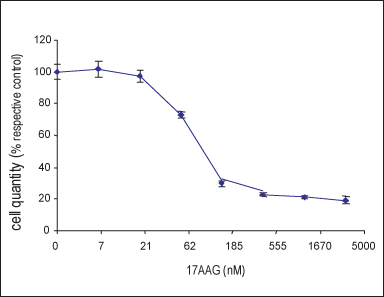Overview
Cat #:
A-580
Alternative Name NSC330507, 17-(Allylamino)-17-demethoxygeldanamycin
Lyophilized Powder yes
Origin Streptomyces Hygroscopicus var Geldanus.
Source Semi-synthetic
MW: 585.7
Purity: >99%
Effective concentration 50-100 nM.
Chemical name 17-Demethoxy-17-(2-propenylamino) geldanamycin.
Molecular formula C31H43N3O8.
CAS No.: 75747-14-7
Activity 17-AAG is a less toxic and more stable derivative of the antibiotic Geldanamycin. It binds to Hsp90 and regulates its function and displays anti-tumor effects1-3.
References-Activity
- Clarke, P.A. et al. (2000) Oncogene 19, 4125.
- Basso, A.D. et al. (2002) Oncogene 21, 1159.
- Schnur, R.C. et al. (1995) J. Med. Chem. 38, 3806.
Shipping and storage Shipped at room temperature. Product as supplied can be stored intact at room temperature for several weeks. For longer periods, it should be stored at -20°C.
Solubility DMSO, methanol. Centrifuge all product preparations before use (10000 x g 5 min).
Storage of solutions Up to four weeks at 4°C or three months at -20°C.
Our bioassay
References - Scientific background
- Clarke, P.A. et al. (2000) Oncogene 19, 4125.
- Basso, A.D. et al. (2002) Oncogene 21, 1159.
- Schnur, R.C. et al. (1995) J. Med. Chem. 38, 3806.
- Nguyen, D.M. et al. (2001) Ann. Thorac. Surg. 72, 371.
- Yang, J. et al. (2001) Cancer Res. 61, 4010.
- Nimmanapalli, R. et al. (2001) Cancer Res. 61, 1799.
- Neckers, L. (2002) Clin Cancer Res. 8, 962.
- Bagatell, R. et al. (2001) Clin. Cancer Res. 7, 2076.
- Chiosis, G. et al. (2003) Mol. Cancer Ther. 2, 123.
Scientific background 17-AAG is a less toxic and more stable derivative of the antibiotic Geldanamycin. It binds to Hsp90 and regulates its function.1 Hsp90 regulates the physiology of cells exposed to environmental stress and in maintaining the malignant phenotype of tumor cells. 17-AAG induces apoptosis and displays anti-tumor effects in tumor cells. 17-AAG depletes cancer cells of erbB-1, erbB-2, Raf-1, and Akt and hence inhibits the Ras/Raf/MEK and PI3-kinase signaling pathways.2,3 It also downregulates vascular endothelial growth factor (VEGF) expression.4 17AAG is currently in phase I clinical trial in several centers worldwide.5-8 Preliminary data obtained from these trials demonstrate that anti-tumor activity is achieved at concentrations below the maximum tolerated dose.9
Lyophilized Powder
17-AAG (#A-580) is a highly pure, semi-synthetic, and biologically active compound.
For research purposes only, not for human use
Last Update: 08/01/2025
Applications
Citations
Citations


